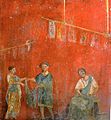Clothing in ancient Rome
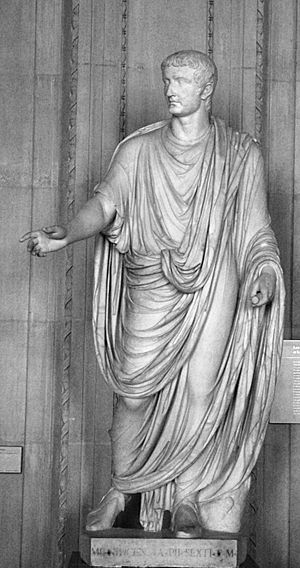
In ancient Rome, the clothes people wore showed their gender, social standing, and wealth. Most Roman clothing was simple. It didn't need much cutting or tailoring. But making clothes by hand took a lot of skill and time.
Spinning thread and weaving fabric were seen as good and careful jobs for Roman women. Even simple clothes were quite expensive compared to the cost of living. So, clothing was often reused many times by different people. Most Romans wore colorful clothes. Clean, bright clothing showed respectability and status for everyone.
The toga was like Rome's "national costume." Only Roman citizens were allowed to wear it. But for everyday life, most Romans preferred clothes that were easier and more comfortable. The tunic was the main piece of clothing for everyone, no matter their social class or job. It was usually made of linen. In colder parts of the Roman Empire, people wore long trousers. Most city Romans wore shoes, slippers, boots, or sandals. In the countryside, some wore clogs.
Contents
The Toga: Rome's Special Robe
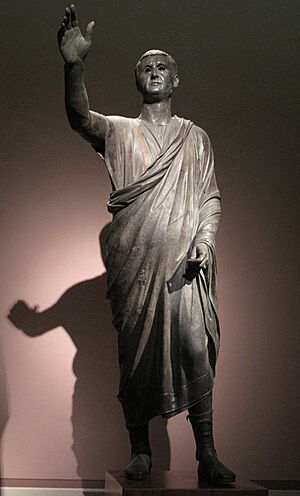
The toga is probably the most famous piece of clothing from ancient Rome. It was more than just a garment. Its style, color, and material told everyone about the wearer's status and age.
- The Toga Pura: This was the simplest toga. It was made of undyed white wool. It was the ultimate sign of being a Roman citizen. A full toga could be very heavy. It took skill to drape it correctly. Putting on a toga was often a special event, sometimes with help from slaves. Imagine it like a very big, heavy cape!
The toga wasn't a "one-size-fits-all" outfit. There were different types for different events:
- Toga Candida (white toga): People wore this when they were running for public office. Think of it as a "campaign toga" to help them stand out!
- Toga Pulla (dark toga): This dark-colored toga was worn during times of sadness or mourning.
- Toga Trabea (purple-bordered toga): This special toga was only for high-ranking officials and important leaders. It showed off their important jobs.
The toga's style changed over many years. Early togas were simpler. Later ones became more fancy, with complex folds. Pieces of wool fabric found in Roman sites help us understand how they wove different types of wool.
Even though the toga was very important for centuries, it became less popular after the Roman Empire grew. It wasn't very practical for daily life. People wore it less often, except for special ceremonies or official events.
The Tunic: Everyday Clothes for Everyone
The tunic was the main piece of clothing for both men and women in ancient Rome. It was a simple, loose-fitting garment. It looked like a long shirt. Tunics were usually made from linen or wool.
The length of a tunic showed a person's social standing. Richer people wore longer tunics. Shorter tunics were common for working-class people.
Tunics could be plain or decorated. They might have embroidery, stripes, or patterns. The colors could also show a specific role. For example, purple tunics might have been worn by certain religious leaders.
The design of the tunic also changed over time. Sleeves, necklines, and fabrics varied. Well-preserved tunics found in Pompeii and Herculaneum (buried by Mount Vesuvius in 79 AD) show us how tunics were made. They also show how they changed over different periods.
The Stola: A Special Dress for Roman Women
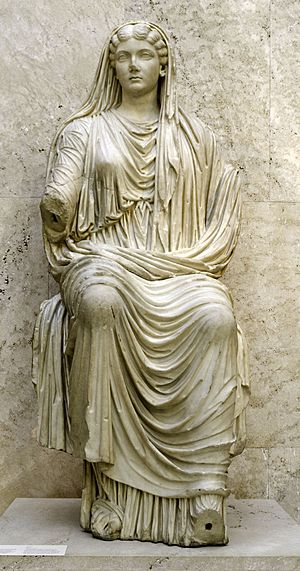
The stola was a long, draped dress worn by Roman women. Like the toga, its style and material showed a woman's social standing.
Stolas varied in length, fabric, and decoration. This depended on the wearer's social status and the event. Wealthy women might wear stolas with fancy embellishments.
Often, women wore a palla over the stola. The palla was a shawl-like garment. It added warmth and elegance. It could be made of different materials and decorated in many ways.
The stola was more than just clothing. It showed a woman's important role in Roman society. How a woman wore her stola could show her status within her family and community.
Footwear and Accessories
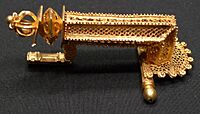
Footwear in ancient Rome included sandals, shoes, and boots. They varied based on social class and what they were used for. Common materials were leather and linen. Accessories included jewelry, hair ornaments, and belts. These showed a person's personal taste and status.
Military Clothing
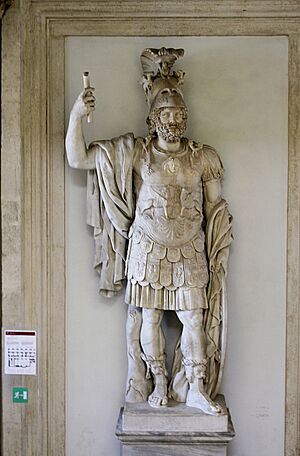
Most common soldiers wore belted, knee-length tunics for work or free time. In the northern parts of the empire, the usual short-sleeved tunic might be replaced by a warmer, long-sleeved one. Soldiers on duty wore short trousers under a military kilt. They sometimes had a leather vest or felt padding to cushion their armor. They also wore a triangular scarf tucked in at the neck.
For extra protection from wind and weather, soldiers could wear the sagum. This was a heavy cloak also worn by regular people. The sagum helped tell common soldiers apart from the highest-ranking commanders. Commanders wore a larger, purple-red cloak called the paludamentum.
In warmer areas, soldiers usually wore hobnailed "open boots" called caligae. In colder, wetter places, they preferred a closed "shoeboot." Some ancient letters, called the Vindolanda tablets, mention families sending clothes. These included cloaks, socks, and warm underwear. They sent them to relatives serving at Brittania's northern border.
Children and Teenagers
Roman babies were usually wrapped tightly in cloths. Most children wore smaller versions of what their parents wore. Girls often wore a long tunic that reached their feet. It was belted at the waist and simply decorated, usually white. Outdoors, they might wear another tunic over it. Boys' tunics were shorter.
Images for kids
-
A 4th-century mosaic from Villa del Casale, Sicily. It shows girls in an athletic contest.
-
A detail from a Paleochristian Roman mosaic in Rome, around 410 AD. It shows Saint Pudentiana.
-
Workers hanging up clothes to dry. This is a wall painting from a fuller's shop at Pompeii.
-
A detail from the marble Altar of Domitius Ahenobarbus, 122–115 BC. It shows two Roman soldiers wearing chain mail and carrying a gladius and scutum.
-
Roman statue of a Virgo Vestalis Maxima (Senior Vestal).
-
The goddess Diana hunting in the forest with a bow. She wears high-laced open "Hellenistic shoe-boots."
-
A detail from the "Big Game Hunt" mosaic from the Villa Romana del Casale (4th century AD). It shows hunters wearing calcei and colorful tunics.
See also
 In Spanish: Indumentaria en la Antigua Roma para niños
In Spanish: Indumentaria en la Antigua Roma para niños
- Biblical clothing
- Byzantine dress
- Clothing in ancient Greece
- Clothing in the ancient world
- Roman hairstyles





